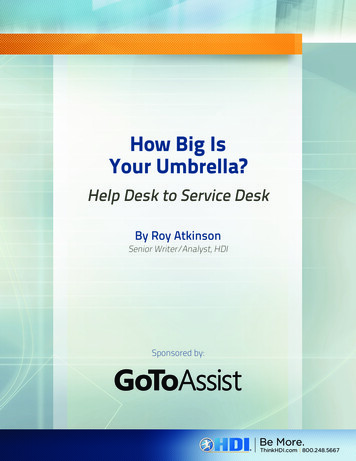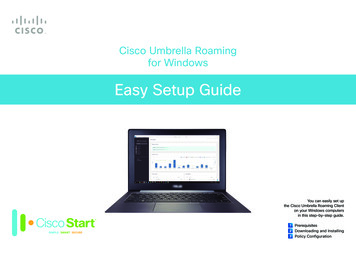
Transcription
How Big IsYour Umbrella?Help Desk to Service DeskBy Roy AtkinsonSenior Writer/Analyst, HDISponsored by:
HOW BIG IS YOUR UMBRELLA?At some point during the last couple of years, you probably got thefollowing question from your management: Should our help deskbecome a service desk?But there’s much more to this transition than a simple name change.It can entail a complete shift in the way you offer support to yourend users and customers, so this bears some exploration.Part of the difference between a help desk and a service desk is thescope of its function—the “size of its umbrella,” if you will. A helpdesk is often one component of a service desk, but there are severalother distinctions worth mentioning:Service desk: The single pointof contact between the serviceprovider and the users. A typicalservice desk manages incidents andservice requests, and also handlescommunication with users.(ITIL 2011 Glossary)1Help desk: A service providinginformation and support totechnology users, especially within acompany (internal).(HDI Glossary) Help desks are mostly reactive: They fix things that arebroken and answer questions Service desks are more proactive: They help manageservices by handling service requests and all customercommunications. Help desks generally give up incident ownership when it is escalated beyond Level 1; service deskstypically retain incident ownership throughout. Service desks integrate more ITSM processes.Before your organization embarks on this transition, there are some fundamental questions you should beasking about the organization’s real needs. Moving from one model to the other can involve a lot of change,and that change should be aligned with your organization’s strategies and goals. If you aren’t sure aboutthose, you need to sort out your strategies first.Help desks, at least when functioning properly, have the difficult task of minimizing IT-related interruptions(i.e., failures, defects, and outages that stop the normal flow of work, etc.). Service desks should be focusedon the lifecycles of organizational requirements. Unfortunately, HDI research tells us that only 29 percent ofsupport organizations believe that their support center’s strategic priorities are aligned with those of nonIT executives in their organizations. 2 If you aren’t sure whether the transition from help desk to service deskaligns with your organization’s goals, ask questions about those goals to make sure you understand them.This, according to some, is the critical difference between a help desk and a service desk: the help desk isfocused on end users, while the service desk focuses more on organizational strategy. 3We shouldn’t proceed further without stating something that should be obvious in the support industry,but isn’t: Help desks and service desks are not software products; they are business units composed ofpeople. When we refer to the software that powers these business units, we should always say so: help deskor service desk solutions (or software, or tools). Your help desk probably isn’t refreshed every three to fiveyears, but your help desk’s or service desk’s software very likely is.1ITIL and IT Infrastructure Library are registered trademarks of AXELOS, Limited.Roy Atkinson, “Show Me the Value: Support’s Mandate,” HDI white paper (November 2013), http://www.thinkhdi.com/ /media/HDICorp/Files/Research-Corner/RC Business Value Nov13.pdf.2See Chris Mackey, “What Are the Critical Differences Between a Service Desk and a Help Desk?,” ARINC Managed Services blog (February 4, 2011), service-deskand-a-help-desk.3 2014 UBM LLC I www.ThinkHDI.com2
HOW BIG IS YOUR UMBRELLA?Should My Help Desk Become a Service Desk?This is a question many organizations have to face, and merely changing the name of the desk won’taccomplish much of anything. As with any fundamental shift in the way operations are conducted, thedecision to move from help desk to service desk should be made with a broad view of how the organizationwill make and support the change. Most transitions require investments of money and time, along withgood organizational change management, and they cannot happen in a vacuum. Along with the specificchanges required to make these changes comes a different kind of commitment to service management.The first question is, Would a transition to service desk better support business goals?There is some evidence that good service management, approached from a broader perspective than just“keeping the lights on” (i.e., fixing what breaks and replacing what you must), can improve the efficiencyand effectiveness of IT. Studies by Forrester, for example, have shown that ITSM increases productivity,increases service quality, and helps control costs. 4There can be little doubt that information technology—in all its facets, from back-office database andserver operations to laptop computers to mobile apps—drives twenty-first century organizations of allkinds, from retail storefronts to educational institutions to manufacturing. Improving the reliability, capacity,and efficiency of these technologies is an integral part of organizational strategy, planning, and operations.Having a service desk that serves as the interface between the organization’s needs and all the servicesrequired to fulfill those needs seems to be a “no brainer.” If, however, your organization—no matter whatkind—is operating efficiently and effectively (at least according to its leaders), why change?No one could argue that business conditions haven’t changed in recent years, especially since the economic“downturn.” Coupled with the increased pace of globalization, the influx of mobile devices and apps, thetrend toward BYOx (device, service, technology.), the ready availability of XaaS (software, platform,infrastructure.), and the cloud, the dependencies and complexities are enormous. Last year, ticket volumesincreased in 66 percent of support centers, and the most frequently cited reasons were changes in thenumber of customers, the number of applications, changes in infrastructure, and the scope of servicesoffered. 5The business and IT have changed. The way the latter supports and enables the former is changing, too.Consumerization has had broad and deep effects on the way information technology and other servicesare delivered. The penetration of tablets and smartphones into the enterprise is undeniable, and ITdepartments—especially support—have been struggling to keep up with the pace of change. 6 At the sametime, customers and users of IT services continue to demand high levels of customer service. Firefightingand ad hoc approaches to service support are no longer good enough (if they ever were).Gains in this area are modest, but still evident. See Courtney Bartlett, with Eveline Oehrlich and Michelle Mai, “The State and Directionof Service Management: Progression, Deceleration, or Stagnation,” Forrester Research (April 14, 2014), http://www.forrester.com/The State And Direction Of Service Management Progression Deceleration Or Stagnation/fulltext/-/E-RES106921;Glenn O’Donnell,with Eveline Oehrlich, Stephen Mann, John Rakowski, Jean-Pierre Garbani, Doug Washburn, and Elizabeth Langer, “The State and Direction of IT Service Management: 2012 to 2013,” Forrester Research (April 24, 2013), http://www.forrester.com/The State And Direction Of IT Service Management 2012 To 2013/fulltext/-/E-RES86722.4Jenny Rains, 2013 HDI Support Center Practices & Salary Report (HDI, 2013), p. 22, ter-reports.aspx.5Jenny Rains, “Mobile Support and BYOD: Where Are We Now?,” HDI Research Brief (November 2013), http://www.thinkhdi.com/ /media/HDICorp/Files/Research-Corner/RC MobileDeviceSupport Nov2013.pdf.6 2014 UBM LLC I www.ThinkHDI.com3
HOW BIG IS YOUR UMBRELLA?How Do We Move From Help Desk to Service Desk?The move from an incident-focused help desk to a strategic service desk is a business decision, not simplya question of buying and installing a tool. It requires business thinking, with a focus on how the investmentsrequired will improve business processes and generate a return on investment (ROI).Good service management begins with a focus on processes: How do we do things now, and how will we do them in the future? Can good service management streamline or consolidate processes that are time-consuming, laborintensive, error-prone, and/or largely manual? Which processes should the organization concentrate on first? Who will manage the organizational change that will be required? How will the culture of the organization affect the required changes, whether positively ornegatively? How much will the organization spend on the required changes? How, and how soon, will the investment be recouped? How many processes will need to be supported in the service desk tool?7All of these questions (and more) should be answered before you even begin contemplating the technologyphase.Based on the answers to those questions, identify or develop requirements and then draft a request forproposal (RFP) that reflects all elements of change. You will need: Senior management sponsorship and/or buy-in, to cut across silos and business units Business sponsors Change management plans to affect cultural change A project plan and manager A marketing plan and a communications plan Plans for role transitions Needs assessments for training (service desk and end users)Defining the Role of the Service DeskOne of the main characteristics of a service desk is that it is intended to be a single point of contact(SPOC). All incidents, service requests, and customer communications should pass through the servicedesk, which is well equipped to deal with them because of its connections to all the aspects of servicemanagement, including incident management, request management, configuration management, accessmanagement, service catalog, change and release management, and knowledge management, includingself-service options.In other words, the service desk sits at the center of a hub of information, and its technology enablesservice desk staff to field and deal with the totality of an organization’s service management environmentSome organizations think they need to maximize the number of processes supported in a tool, only to find out later that they weren’tusing many of the tool’s capabilities.7 2014 UBM LLC I www.ThinkHDI.com4
HOW BIG IS YOUR UMBRELLA?and be much more proactive than a help desk. The service desk solution software itself, while invaluable, isnot the only factor that determines the success of the service desk. An organized, well-laid plan is at leastas important.Service desks, enabled by remote support tools and collaboration tools, are increasingly absorbing dutiesthat used to require deskside support. More than half (52%) of support centers say that remote supporttools are required to provide successful end-user support. 8The Top Ten Technologies Required to Provide Successful End-User Support(Survey respondents were asked to select up to five options.)67.967.5Incident management57.4Knowledge management49.852.0Remote control43.241.141.8Customer satisfaction surveying31.0Automated call distributor33.0Self-serviceAsset managementProblem hange management29.220.825.818.423.818.325.0Percent of support organizationsIn addition to these responsibilities, some service desks are expanding their purview by becoming the pointof contact for HR, facilities/maintenance, and other business units that have customer contact and serviceneeds. Since the service desk is business-focused and strategic, it’s well worth considering whether these orrelated options would be advantageous for your organization.Jenny Rains, 2013 HDI Support Center Practices & Salary Report (HDI, 2013), p. 33, ter-reports.aspx.8 2014 UBM LLC I www.ThinkHDI.com5
HOW BIG IS YOUR UMBRELLA?It’s a Journey, Not a DestinationEven if you’ve been going in this direction for some time, your service management journey is onlybeginning. Continual service improvement is built into the concept of service management, and allyour processes should be reviewed on a regular basis to make sure you’re doing the right things—anddoing them right. From the way you handle incident management to the metrics you collect and report,everything deserves continued attention and updating. Whatever method you use for improvement—Kaizen, for example—should be applied to all aspects of the service desk (or the help desk, for that matter).9ConclusionsAlthough the names are often used interchangeably, there are substantial differences between help desksand service desks. The former is supports end users, while the latter is a strategic component of servicemanagement. If you choose to make the move from help desk to a service desk, it’s important to have asolid plan and to make sure that your goals are aligned with your organization’s strategies. Plan for everyaspect of the task, including organizational change and training needs. Have a high-level sponsor and solidmanagement support. Remember that the tool itself will not guarantee success, but the way you use thetool could very well be a significant factor.In short, make sure your umbrella is as big as you need it to be—for today and tomorrow.9“Kaizen,” Wikipedia (last modified April 22, 2014), http://en.wikipedia.org/wiki/Kaizen. 2014 UBM LLC I www.ThinkHDI.com6
HOW BIG IS YOUR UMBRELLA?About the AuthorRoy Atkinson is HDI’s senior writer/analyst. He is the chief writer for whitepapers and SupportWorld articles, as well as a key in-house subject matterexpert. Roy has an extensive background as a practitioner in IT support andcustomer service. He served as technical lead for an award-winning enterprisesoftware implementation, and as project manager for many others. Roy is aformer member of the Apple Consultants Network. He is a frequent speakerand writer on social support, customer service excellence, and mobile devicesupport, and he serves on the HDI International Certification StandardsCommittee.About HDIHDI is the professional association and certification body for the technical service and support industry.Facilitating collaboration and networking, HDI hosts acclaimed conferences and events, produces renownedpublications and research, and certifies and trains thousands of professionals each year. HDI also connectssolution providers with practitioners through industry partnerships and marketing services.Guided by an international panel of industry experts and practitioners, HDI serves a community of morethan 120,000 technical service and support professionals and is the premier resource for best practices andemerging trends.About GoToAssistGoToAssist is a cloud-based, integrated support toolset that offers a “triple play” combination of easy-touse service desk management, market-leading remote support, and IT monitoring. With easy access to keysupport functions from one interface, GoToAssist enables IT to maintain uptimes for people and deviceswhile delivering superior support experiences. To learn more about GoToAssist, or request a free trial, visitwww.GoToAssist.com. 2014 UBM LLC I www.ThinkHDI.com7
Your help desk probably isn’t refreshed every three to five . departments—especially support—have been struggling to keep up with the pace of change.6 At the same time, customers and users of IT services continu











